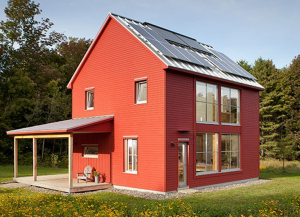 My husband and I are debating one of the biggest financial decisions of our lifetime: whether or not to build a super energy efficient home, called a Passive House. The nut of it is that we could buy a similar sized traditional home for about $100,000 less.
My husband and I are debating one of the biggest financial decisions of our lifetime: whether or not to build a super energy efficient home, called a Passive House. The nut of it is that we could buy a similar sized traditional home for about $100,000 less.
Should we spend $100,000 extra for a Passive House?
Dear reader, whether to build this home is an incredibly personal decision my husband and I are in the process of making. Which is why I’m asking for your thoughts. I’ve always turned to the thoughtful and supportive and honest BargainBabe.com community when I have a true financial dilemma. What would you do in my situation?
Cons of building
- The main drawback to our dream of building a Passive House is the cost. Buying land where we want to live (with good schools and an incredibly low tax rate) is expensive compared to other parts of the country. But we know that this particular town has very good housing values and is a desired community in the region. Hence the cost of buying land there. We estimate the cost of buying land *and* building a Passive House in this town to be $550,000.
- For about $450,000 we could get a very nice home in the same town, though it wouldn’t have any of the same energy efficient measures, including namely triple paned windows and 12-inch thick walls crammed with insulation. It would be a traditional 3BR home that would need some work and carry an annual heating and cooling bill of about $3,000. It would have enough space and likely a full basement and perhaps a garage.
- The home we plan to build will be smaller than what we would get if we bought an existing home. Several hundreds square feet less, and we’re not sure if we can afford a garage immediately. We can build one ourselves down the road if need be.
- If you figure the annual savings on heating and cooling is $2,700, and the annual savings on maintenance is $2,000 (we expect minimal maintenance on a new home), that is a yearly savings of $4,700. If we figure the upfront investment is $100,000 greater, our payoff is 21 years and four months. That’s a very long term investment. Lots of things could change in that time.
- On top of the long payback period, the day our home is finished, we will be able to sell it for $425,000. But we’ll have spent $550,000 to buy the land, develop it, and build our dream home. That’s a big hole we’re digging for ourselves.
- If we needed to move, we basically won’t be able to. So much of our money will be tied up in the new home that we’ll need to live there at least 20 years – maybe longer.
- The process of building a home is going to be extremely time consuming (imagine all those permits and approvals we have to get), stressful (dealing with contractors and builders is not something I relish), and require us to make hundreds of decisions that carry major consequences.
Pros of building
- Our hearts are set on building a Passive House. Why? Because they are utterly amazing. Imagine walking into a home that is so airtight, when you close the front door you hear a delicious silence. The air is incredibly fresh, as if you were outside, because fresh air is continually being pumped into your home. You pass by a window and instead of a winter chill, the temperature remains a comfortable 68 degrees. Your windows are so large and present in the design of your home that the outdoor beauty of your garden invites itself into your living rooms. So much natural sunlight means you rarely turn on lights during the day. We want one of these homes, badly.
- Our annual heating and cooling bill will be about $300. How is that even possible? A Passive Home is so well insulated – from the roof, to the walls, windows, and basement – that there are no drafts. No air leaks in or out. When you heat – or cool – a passive house, you barely need to put in any energy to keep the temperature at the desired level. Think of it as an airtight box that holds onto any heat or cool air you put into it.
- On top of the energy savings, we get a new home that doesn’t need any fixing! Our current home is 110 years old and constantly needs fixing. But a new Passive Home is built to last, with cement siding requiring no annual upkeep, a metal roof that lasts 50 years, and new interiors that are level and square.
- We have spent a lot of time in the town where we’d like to build and are confident that we will enjoy living there. Many, many friends have also said good things about the town, too.
- We’ve checked out the schools and they are excellent. The schools where we currently live are poor, which is one of the main reasons why we plan to move.
- The new town is a shorter commute for my husband, which means more time together and less money spent on gas and car maintenance.
- We have found a build-design firm whose work we love. We’ve also done extensive research on them, including talking at length to two previous clients, who both gave outstanding reviews.
- We have the savings to build the home we want, but it will tap every account we have built up over the years. The project will NOT, however, require us to make early withdrawals on our IRAs or 401(k)s.
- We plan to live in the home throughout our retirement, and in some ways, a Passive Home is ideal for retirees. Our heating and cooling bill will be almost nonexistent, so we’ll need less money each month in retirement.








I think it’s really difficult to plan into any home what you want for the next 20 years. Consider that the commute will likely change, you’ll get to the point where the schools won’t matter anymore, etc. Planning that far ahead is so difficult. That’s my only thought on the minus side. You’ve covered the plus side pretty well!
@Lori You’re spot on. We have tried to plan for what we will want in a house in 20 years – including a first floor bedroom and full bath – but there’s no telling where we will be working and where our kids will be in school. The long term-ness of the gamble is a big part of what makes us nervous about the decision. Much easier to plan for the short term.
I don’t envy your decision, and like the other reply I agree you’ve covered all the pluses. As Lori said, tho, 20 years is a long time to think ahead, and you can only suppose what is going to happen. As long as you’re not tapping into what you consider your retirement money, I think I would go with it!
@Michelle Turchin Ventresca Thanks for your vote of confidence, Michelle! Whether we build this Passive House or not, I want our next home to be a very long term landing place simply so we can feel like we are HERE. We’ve landed. We’re putting down roots – ones that we won’t have to dig up in a few years. I’ve lived in seven different places in the past 12 years – that’s a lot of moving! And part of me wants the mental freedom of knowing, we are going to be here for decades, not just a few years. We’ve been debating where to move, where to send our kids to school, where to work for so long. Once we settle it, we can focus on more enjoyable things.
Before you know it, those 20 years will be behind you and you and your family will still be enjoying a relatively new passive home.
@Fran I never thought of it that way!!! Hehehe, yes, I think if we build this home we will enjoy it for a long, long time.
Sounds like you “want” this and it’s an emotional decision for you. Take the emotion out of it. Can you afford it? Can you cover the $125,000 deficit you will be in upfront? In other words, if you had to sell in the next few years, would that “destroy” you financially? Can you save enough for retirement and college education and still afford the home at the same time? Good luck!
@Bob Excellent questions. It definitely is an emotional decision. We’ve both tried to take the emotion out of it – it’s pretty clear we WANT the home – and focus on the numbers. So, to answer your questions:
1. Yes, we can cover the deficit upfront if we sell most of our stocks and our current home.
2. If we had to sell it in a few years, it would be a big financial hit. We would still have our retirement accounts, but we would lose that upfront investment that we calculate will pay off in 21 years via marginal heating/cooling costs and low maintenance costs.
3. We are still saving for retirement and college for our girls and do not anticipate that those contributions will be lowered as a result of this project. However, we will have less money for travel, restaurants, vacations, and clothes. It’s going to be tight for a few years, or at least until I take on more work and contribute more to our budget.
Hi Bargain Babe,
I really enjoyed your article – thank you! You seem to write with a lot more passion when it comes to building a passive house and that kind of passion can have far reaching consequences in other parts of your life too. If you build a place you love, the positivity you feel attracts other good things into your life. Who knows – you might even get a pay rise that helps you pay off the house a lot sooner! If you build a traditional 3 bedroom place, you’ll always feel like you settled for 2nd best…
Good luck with the decision! Cheers, Sam – Houseplanology.com.
@Sam Hi Sam, welcome to BargainBabe.com! Thanks for your thoughts. We truly are passionate about owning a Passive House, which is the only reason we are considering sinking so much money into the project! I agree that the happiness that we will (hopefully) experience if we one day move into our Passive Home could bring other good things into our lives. And at the least, we’ll love the home we live in!
Ps. Checked out your site. Congrats on a cool site! WHere is your category for green homes? Under construction, I hope. If I may offer some feedback, it’s a tad unclear from your tagline what you offer. I wonder if you adjusted your tagline “a world of house plan sites and more” to be more descriptive if it would help. “House plan site” is a bit unclear to me, and it could just be me. Maybe sometime like “find plans for your dream home here.” Of course, you have a nice graf describing what’s on your site just below the tagline, so maybe an edit isn’t needed after all.
To paraphrase Cary Grant from the movie Mr Blandings builds his dream home, “some things you buy with your heart, not your head”. But that movie was made some 70 years ago and things have changed dramatically.
Having more than 45 years hands-on experience as designer and builder, constructing everything from garages to big-box commercial structures, I can give you the benefit of some real-life experience.
Having built homes that are airtight (to the extent that opening the front and back doors and then closing one will cause the other to shut) might sound like a good idea, but there are some major drawbacks. Interior air quality being one, but only one.
You say you will have a circulating fan to introduce fresh air. Using electricity(in a passive solar) to do what a better-designed home with small areas of less well-insulated infiltration pockets will do free and automatically? Buildup of noxious chemicals from literally everything that you bring into the house, and don’t forget the hazardous chemicals in all interior finishes. Chemical overload from the very beginning. Over-insulated and under-ventilated spaces trap these chemicals for many years. You’re gonna want all the positive fresh-air flow you can afford for a minimum of 6 moths after construction.
Passive solar? Do some more research and talk to people that have lived in such homes for a minimum of 2 complete solar years in the area that you are considering and see what the real pros and cons are. Hot spots in rooms? You can bet your grandmother’s bloomers, even with low E units. Which, by the by, negate most “benefits” to having passive solar.
$125k in the hole from the time you purchase? And you are still questioning the advisability of such a decision? Research the bell-curve cost of owning a home for a 20 year period to find the real “sweet spot” between appreciating and depreciating values. You’re gonna be surprised.
Frankly, I think someone is selling you an over-priced pig-in-a-poke. You wouldn’t be the first to take the bait.
Either they don’t know or simply aren’t telling you the truth about many things, like for instance the long-range r-value loss of structures over a 20 year period.
Residential metal roof that lasts 50 years? Have the manufacturer show you one of their products that has lasted anywhere near that long, if they can(Which I seriously doubt). How many time was it “maintained”, what did the “maintenance” entail, and at what cost?
1. Educate yourself re the subject more, much more.
2. Get a more knowledgeable/honest designer/builder. There is no rational reason why the cost difference would be anywhere near the range you speak of. Pretty difficult(impossible) to “upgrade” an “average” sized home with that much “passive solar” features to justify such an outrageous difference.
3. Consider other methods to achieve what you think passive solar offers. They exist. At much more attractive price points.
Still, if you are determined to buy with your heart, that is your decision. But strictly from an “investment” or wise financial decision perspective, it can never be justified. Nowhere near.
Hope that helps.
ps. I have some ocean-front property in Arizona for sell. Real cheap!
@John Heineman I truly appreciate the time you spent replying to my post! I agree with much of what you point out – we are making this decision with our heart as well as our minds. Here are my thoughts on your concerns.
1. Indoor air quality – Passive Homes actually have superior air quality because of their built in ventilation systems. It’s not a fan as much of as a whole house ventilator. A bit more about ERV’s: http://en.wikipedia.org/wiki/Energy_recovery_ventilation In the home we are looking at building, all of the interior air would be replaced every three hours. That’s fresher than leaving all your windows open! In my current traditional home, we have to close our windows and doors for several MONTHS of the year because it is so cold outside. Imagine living in a house, in the middle of winter, and having fresh air. If you’re thinking – that’s got to be expensive heating (or cooling) all that air being pumped into the house – it’s not. The heat (or chill, depending on the season) of the outgoing air is captured and used to heat/cool the incoming air. It’s extremely efficient. We plan to use low VOC paints.
2. We have talked to several people, and read many blogs, about living in a Passive House. The ERV’s help to circulate the air, and the triple-paned windows are filled with argon, which minimizes the heat transfer. Several people have told us that their homes to not overheat and have a consistent temperature throughout. It’s pretty unbelievable at first, but we’ve been inside several Passive Homes and it really is true.
3. Overpricing. The cost of building a Passive House is 5-7% more upfront compared to building a tradition home, but in energy savings you recoup that in roughly 8 years. The home we want to build will cost about $450,000 to build and will appraise for about $425,000 (or more if we can find a green lender in RI!). It’s the cost of the land that is making the deficit $125,000. If we opt for another town, we could get a nice piece of land for about $50,000. I won’t go into the laundry list of pros and cons for each town. We may well lower our land budget, however, because we share your same concerns about the upfront investment.
4. I will ask about loss of R-values over time as well as the warranty on the roof. I believe it is 30 years but I’ll double check.
5. We continue to research this project and hope to learn much more about it before we begin.
6. We have spoken to three clients of the design-build firm we’d like to work with and they all gave stellar reviews. We also met with the firm partners and spent several hours with them discussing the project. They were upfront and professional the entire time.
7. I’m not sure what you mean by other methods to achieve what we think passive solar offers. We know what passive solar offers – what other means are you suggesting?
8. Send me for the listing for the ocean front property in AZ. Sounds unbelievable! 🙂
8. Ha! Great sense of humor. Very important in life.
7. English language is sometimes very imprecise. Think was meant to convey thought of expectation, not lack of knowledge.
ps appeals to most. including myself mainly because of three reasons, all of which you mention; sunlight, open feel, energy conservation. ps is only one design that attempts to achieve this.
6. Answer to #4 should have been one of the main points in discussing long-term hypothetical savings. Not only r value of insulation but the same applies to u factor of windows. Knowing the right questions to ask is extremely important.
Re roof, even if warranty is for 30 years, same applies as in my original post. The true answers may dismay you, or not, depending on your preference for a certain design element.
5. Good on you! You can never have too much truthful information.
4. See #6 above.
3. 5% to 7% can be a reasonable upgrade cost for ps construction. Depends.
Don’t know what price per kwh you are paying in Rhode Island? The h/c cost for my 2400sf heated space ‘conventional’ (but self-built) home has an annual cost of less about $1000.
Temps vary from 105 to -15 fahrenheit. Cost per kwh varies from 12 cents to 26 cents, depending on season of year. Therm set to 68 for heating, 74 for cooling. Ceiling height ranges from 8′ to 14′.
Land cost of 125k? Hmm… Location can be very important for many reasons. Guess I misunderstood your original post. Thought you said ps construction was the reason for the cost differential.
2. I am greener than most people you will ever meet. Was green decades before it was mainstream cool, when it was very fringe and extremely weird. Back when a vw beetle was cheap transportation. So green I think I am really a Martian.
Have lived in a ps home at 34 degrees lat in the past. I suppose ‘hot spot’ can be very subjective to a person’s perception. But hot spots there will be. Just use a thermometer correctly and you will see. It is unavoidable in a passive solar scenario during certain times of the day, depending on what lat the home is in. Just think about it and you will see that it is true.
Doesn’t matter if the insulation is batt, blown, sips, or stress panels. U factor of windows can moderate differential a little, but only a little.
ERV can help to moderate temp differential, but any cost savings are at best marginal. Pay a lot comparatively to get a little.
1. ERVs are not new technology. Concept has been around for millenniums.
ERV can replace a certain cf volume of air in a given time.
If anyone, and I do mean anyone tells you that ALL the air will be replaced every 3 hours, they are either delusional, misinformed, or very careless with the truth.
If they insist that it is true, have them show you your floor plan and explain just how the air will be evenly replaced in every room, on every floor, from ceiling to floor or vice versa, at the same time within the claimed time period, if at all. What they are claiming to achieve with ERV defies the laws of physics and thermo dynamics. Impossible.
The cost of a system that could truly perform such a feat would be extremely prohibitive and design-intrusive. I know from experience. Many tests have proven the fallacy of this marketing ploy. Sells a lot of equipment though. Caveat emptor.
But truly clean indoor air may not be a high priority for you. All things are relative and subjective.
In closing, I applaud your desire to give ps a try. Been there, done that. Certainly better than an energy hogging Mcmansion. Not trying to discourage, rather to educate you just a very little about some things that most professionals in the industry don’t or won’t talk about, even if they know. No housing choice, regardless of the cost, is ever perfect. There are always trade-offs to be made.
If you know the true cons, then you can make a truly informed decision, have expectations based on facts, and be happy with your decision. Dick Proenneke was happy in his cabin, but he knew what the realities were before he built. Knowledge based on facts is power.
Wish you well in your home endeavor.
I have never heard of a passive house before. It sounds nice!
@Michelle They are super cool! Here is the Wikipedia page about Passive Houses: http://en.wikipedia.org/wiki/Passive_house
The Passive House Institute US page is here: http://www.phius.org/home-page
If you are building a Passive House, why not use cats as your heat source…
http://www.c60design.co.uk/many-cats-take-heat-passive-house/
@Roger Perrott Great question! Is anyone crazy enough to own 18 cats? Not me! We have one small dog and that is one small dog too many!
Hello,
It is 2017 now, a few years after the last posts. Did you ever build your home to passive house standards?
If so, how do you like it? I would appreciate learning more about the comfort level.
Jasmine
That’s a significant decision indeed! While weighing the options, have you considered exploring real estate opportunities in Thailand? Thailand Real Estate showcases properties that might align with your investment considerations. Building a super energy-efficient home is a commendable choice, and diversifying investments in real estate could also be a strategic financial move for the long term.
web: https://thailand-real.estate/
Homeowners seeking elegant, designer-inspired interiors can rely on OTILE for premium tile solutions. With a vast range of styles, textures, and finishes, achieving a high-end look has never been easier. Explore their collection at https://otile.com/ to find tiles that elevate every room, from kitchens to bathrooms. OTILE combines quality with aesthetic appeal, making it simple for anyone to replicate professional designs. Transform your space effortlessly and enjoy long-lasting, luxurious results that impress guests and enhance your home’s value.